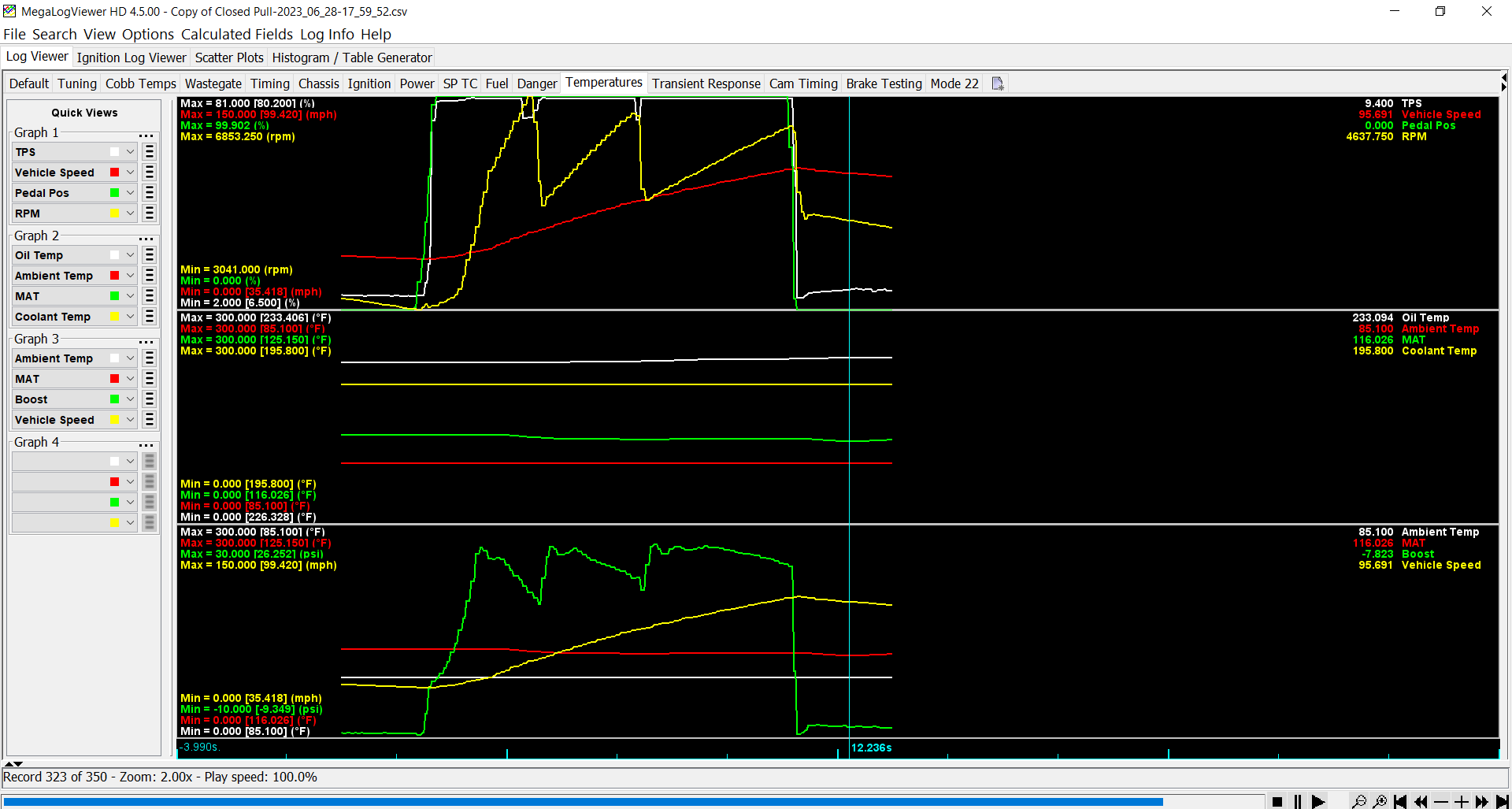Hood Tuft Testing Seibon Carbon Vented Hood
And the start of diagnosing horrible IATs on a Golf R
If you happened to skim the Intake Air Temps (IAT) of all the samples from my article about logging cooling temps on track, then you may have noticed that one sample stuck out like a sore thumb: Samples 1 + 2 from user “redslaya”.
Sample #1 had the OEM intercooler and showed a 65F delta IAT over Ambient Air Temp (AAT), so we didn’t really think much of it back in August of 2022 when it was taken. So the next logical step was to install an intercooler.
Notice an APR IC, ALL (3) CSF auxillary radiators, a vented hood, and a 19 row oil cooler - but look at how much higher the IATs are over ambient?
He came over and I helped him install an APR SMIC early in 2023, which we thought would fix his problems.
In May 2023 we were back at VIR and logged data again and it was obvious there was still an issue: his IS38 S1 APR Golf R was only hitting 132mph on the back straight at VIR… the exact same as my IS20 S1 GTI on the same day at a Tidewater Sports Car Club HPDE. An IS38 car should be plenty capable of hitting 140-145mph based on data from other cars at the same track.
I had approximately 14 samples at the time of many other cars and setups, some including the stock intercooler, it was apparent that this car was not like the others. Every single other [aftermarket IC] sample had IAT Delta averages in a very narrow spread: 18-25F over ambient, with only a couple outside that range (considered outliers, but nowhere near the 55F delta of his car).
There were not many CSF radiator sample cars at the time we originally started looking into this. Our original hypothesis was that airflow may have been a problem. Either from the CSF radiator restricting airflow externally, and/or from the Seibon vented carbon hood having less than optimal placement of the vents.
Track days are expensive, so we set out to determine as much as we could by implementing street testing. Also we’re lazy. And this was easiest to rule out with minimal real effort.
It started by using yarn tufts all over the hood to see if air was flowing in or out of the Seibon hood vents. Interestingly enough we found that the tufts at the forward part of the hood were actually getting sucked back into the vents.
Marked radiator placement in relation to hood vents.
Notice how far forward the front vents are? Being above/in front of the radiator won’t help evacuate anything.
While performing the tuft testing, we were also logging IATs at the same time, and I loaned him my spare Simos Tools dongle to gather some more data on his own, which he sent to me for analysis:
2018 Golf R
APR Stage 1 tune
APR Intercooler
APR CF Cold Air Intake
CSF Radiator
Seibon vented hood - vents OPEN
Results: 84F ambient, IATs leveled out at 118-121F after 20+ min of highway cruising. The start of the pull was 122F, and only dropped to 118F.
After doing that, we performed the same test on the same route with the vents CLOSED (using the supplied “rain guards” that Seibon provides to block the holes).
Variable changed:
Seibon vented hood - vents CLOSED
Results: 85F ambient, IATs leveled out between 116-118F after 20+ min of highway cruising. IATs dropped from 125F down to 118F during a pull. So marginally better, admittedly likely within the margin of error of our testing. Obviously not the root cause of IAT problems.
So he changed one more variable because it was quick and easy to do:
Replaced APR CF Cold Air Intake with OEM VW intake
Note: Still with Seibon hood vents CLOSED
Results: 82F ambient temp, IATs settled at 109F cruising, IATs only went from 116 down to 114F during a pull.
So none of these changes were really the root problem. The APR intake seemed to heat soak a bit more while cruising vs the OEM plastic intake, but WOT differences vs ambient were pretty negligible when ambient vs IAT was factored in (and I consider within margin of error of testing).
So after this bit of testing we also opted to throw on my newly-vented stock hood with a 24x16.5in RaceLouvers vent installed just to see for the heck of it. This was not nearly as well tested (controlled) as the above, as it had to be done on a different day, and we were really just looking for any kind of major changes in results.
Somewhere in the 20min drive log were a few WOT pulls (granted not FULL 3rd gear pulls), but regardless you can see the IATs never got lower than 111F, highest ambient was 87F, so 24F over ambient. Better than with the other hoods, but not considerably so. This is still approximately 10-15F higher than we’d expect for a street pull.
Reminder: While he was seeing 55F over ambient on track, it was never this bad on the street. We were mainly trying to get the IAT down to within 10F of the AAT during a pull on the street, which is far more typical vs the 25-30F difference we were seeing.
So with the hood vent and intake ruled out, it was time to look at the next suspect: the oil cooler. Check out the next blog post for details.

















